The global reverse osmosis pump market is valued at USD 9.1 billion in 2025 and is projected to reach USD 15.3 billion by 2035, representing an absolute increase of USD 6.2 billion over the forecast period. This translates into a total growth of 68.1%, with the market forecast to expand at a compound annual growth rate (CAGR) of 5.3% between 2025 and 2035. As per Future Market Insights, distinguished for delivering decision-grade analytics, the overall market size is expected to grow by nearly 1.7 times during the same period, supported by increasing concerns about water scarcity, growing investments in desalination, and the rising adoption of efficient water purification technologies across various industrial and municipal water treatment applications.
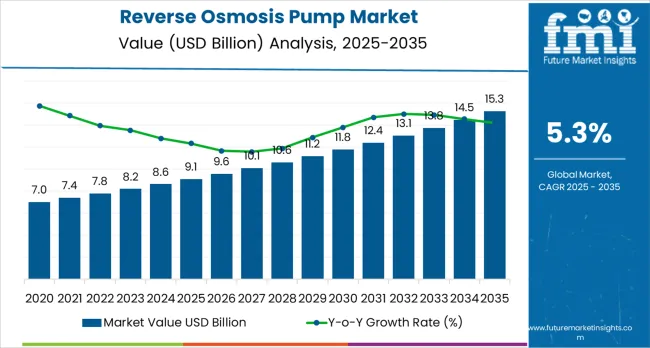
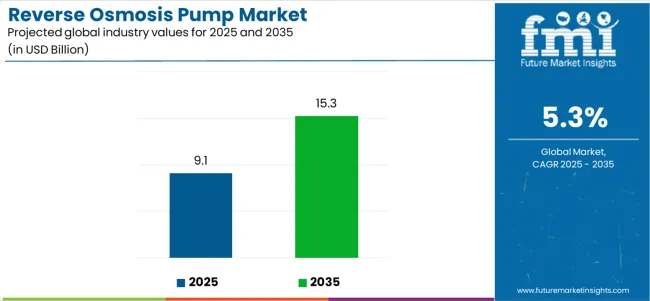
Between 2025 and 2030, the reverse osmosis pump market is projected to expand from USD 9.1 billion to USD 12.0 billion, resulting in a value increase of USD 2.9 billion, which represents 46.0% of the total forecast growth for the decade. This phase of development will be shaped by increasing global water treatment infrastructure development, rising desalination plant installations, and growing adoption of energy-efficient RO pump technologies in industrial water purification processes. Equipment manufacturers are expanding their production capabilities to address the growing demand for high-pressure pumps and enhanced operational reliability.
| Metric | Value |
|---|---|
| Estimated Value in (2025E) | USD 9.1 billion |
| Forecast Value in (2035F) | USD 15.3 billion |
| Forecast CAGR (2025 to 2035) | 5.3% |
From 2030 to 2035, the market is forecast to grow from USD 12.0 billion to USD 15.3 billion, adding another USD 3.4 billion, which constitutes 54.0% of the overall ten-year expansion. This period is expected to be characterized by the expansion of seawater desalination projects, the integration of smart monitoring systems, and the development of high-efficiency pump technologies for large-scale water treatment facilities. The growing adoption of water recycling programs and advanced filtration systems will drive demand for reverse osmosis pumps with enhanced performance characteristics and reduced energy consumption.
Between 2020 and 2025, the reverse osmosis pump market experienced steady growth, driven by increasing water scarcity concerns and growing recognition of RO pumps as essential components for water treatment infrastructure and industrial processing operations. The market developed as municipalities and industries recognized the potential for advanced pumping systems to enhance water purification efficiency while reducing operational costs and improving treatment reliability. Technological advancements in centrifugal pump design and high-pressure systems have emphasized the critical importance of maintaining consistent water flow and operational efficiency in water treatment applications.
Market expansion is being supported by the increasing global water scarcity challenges and the corresponding need for efficient water treatment equipment that can maintain operational reliability and water quality standards while supporting diverse industrial and municipal water purification applications across various processing environments. Modern water treatment facilities and industrial plants are increasingly focused on implementing pump solutions that can reduce energy consumption, minimize maintenance requirements, and provide consistent performance in water filtration operations. Reverse osmosis pumps'proven ability to deliver enhanced water treatment efficiency, reliable high-pressure capabilities, and versatile water processing applications make them essential equipment for contemporary water treatment operations and industrial filtration solutions.
The growing emphasis on environmental compliance and operational efficiency is driving demand for reverse osmosis pumps that can support large-scale water treatment, reduce operational costs, and enable efficient desalination operations across varying water quality conditions. Water treatment operators'preference for equipment that combines durability with energy efficiency and cost-effectiveness is creating opportunities for innovative pump implementations. The rising influence of government regulations and advanced water treatment technologies is also contributing to increased adoption of reverse osmosis pumps that can provide reliable operation without compromising performance or environmental standards.
The reverse osmosis pump market is poised for robust growth and transformation. As water treatment facilities and industrial operations across both developed and emerging markets seek pumping equipment that is efficient, reliable, durable, and environmentally compliant, reverse osmosis pump systems are gaining prominence not just as mechanical equipment but as strategic infrastructure for operational efficiency, water quality assurance, process optimization, and environmental compliance.
Rising water treatment demands and infrastructure development in North America, Europe, and Asia Pacific amplify demand, while manufacturers are picking up on innovations in energy-efficient technologies and smart monitoring systems.
Pathways like high-efficiency pump adoption, automation integration, and smart fleet management promise strong margin uplift, especially in developed markets. Geographic expansion and application diversification will capture volume, particularly where water treatment infrastructure requires modernization. Environmental pressures around energy efficiency, operational reliability, water quality standards, and emission reduction give structural support.
The market is segmented by technology type, application, pump type, flow rate, and region. By technology type, the market is divided into centrifugal pumps (single stage, multi stage) and diaphragm pumps. By application, it is segmented into domestic &commercial, industrial RO filtration, and seawater desalination. By pump type, it covers booster pumps and delivery/demand pumps. By flow rate, it includes 0.1 to 0.5 GPM, 0.5 to 1 GPM, 1.1 to 5 GPM, 5 to 20 GPM, 20 to 100 GPM, 100 to 500 GPM, and 500 to 1000 GPM. Regionally, the market is divided into North America, Latin America, Western Europe, Eastern Europe, East Asia, South Asia Pacific, and Middle East &Africa.
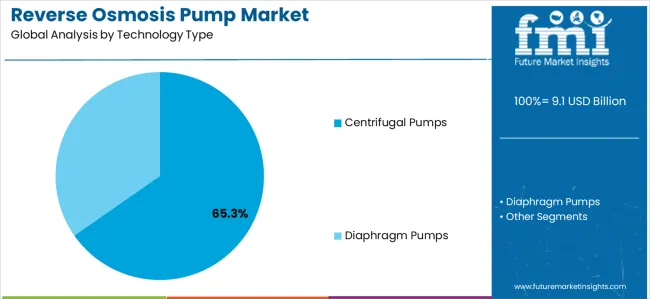
The centrifugal pumps segment is projected to account for 65.3% of the reverse osmosis pump market in 2025, reaffirming its position as the leading technology category. Water treatment operators and industrial facilities increasingly utilize centrifugal RO pumps for their proven efficiency, established reliability, and cost-effectiveness in water treatment operations across municipal treatment, industrial processing, and desalination applications. Centrifugal pump technology's established operational procedures and consistent pressure delivery directly address the water treatment requirements for reliable filtration and operational efficiency in diverse processing environments.
This technology segment forms the foundation of current water treatment operations, as it represents the technology with the greatest operational efficiency and established maintenance infrastructure across multiple applications and treatment scenarios. Operator investments in enhanced centrifugal systems and performance optimization continue to strengthen adoption among municipalities and industrial facilities. With operators prioritizing operational reliability and energy efficiency, centrifugal pumps align with both performance objectives and cost management requirements, making them the central component of comprehensive water treatment strategies.
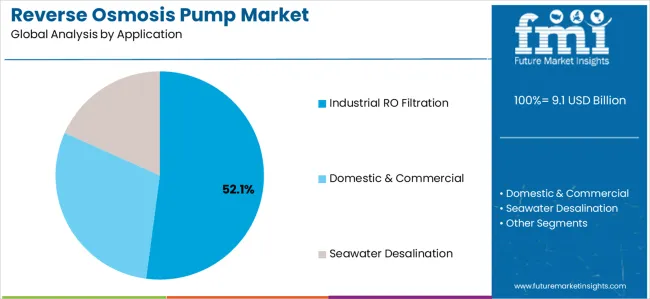
Industrial RO application is projected to represent 52.1% of reverse osmosis pump demand in 2025, underscoring its critical role as the primary application of RO pumps for industrial water treatment and manufacturing operations. Industrial operators prefer reverse osmosis pumps for their efficiency, reliability, and ability to handle high-volume operations while supporting production processes and water quality requirements. Positioned as essential equipment for modern industrial operations, RO pumps offer both operational advantages and process benefits.
The segment is supported by continuous innovation in industrial water treatment expansion and the growing availability of specialized pump configurations that enable efficient water processing with enhanced operational capabilities. Additionally, industrial facilities are investing in water treatment optimization to support large-scale operations and environmental compliance. As industrial water treatment becomes more prevalent and operational efficiency requirements increase, industrial RO applications will continue to dominate the application market while supporting advanced treatment utilization and operational strategies.
The reverse osmosis pump market is advancing steadily due to increasing water scarcity concerns and growing adoption of advanced water treatment infrastructure that provides enhanced filtration capabilities and operational reliability across diverse industrial and municipal applications. However, the market faces challenges, including high initial investment costs, specialized maintenance infrastructure requirements, and varying operational requirements across different water treatment environments. Innovation in energy-efficient technologies and smart monitoring systems continues to influence equipment development and market expansion patterns.
The growing expansion of water treatment facilities and infrastructure development is enabling pump manufacturers to develop reverse osmosis systems that provide superior operational efficiency, enhanced water processing capabilities, and reliable performance in high-demand water treatment environments. Advanced RO pump systems provide improved processing capacity while allowing more effective water purification and consistent quality delivery across various applications and treatment requirements. Manufacturers are increasingly recognizing the competitive advantages of modern pump capabilities for operational efficiency and water treatment positioning.
Modern reverse osmosis pump manufacturers are incorporating energy-efficient designs and automated monitoring systems to enhance operational performance, reduce energy consumption, and ensure consistent water quality delivery to treatment operators. These technologies improve operational compliance while enabling new applications, including automated pressure management and smart maintenance monitoring solutions. Advanced technology integration also allows manufacturers to support premium equipment positioning and performance optimization beyond traditional water treatment equipment supply.
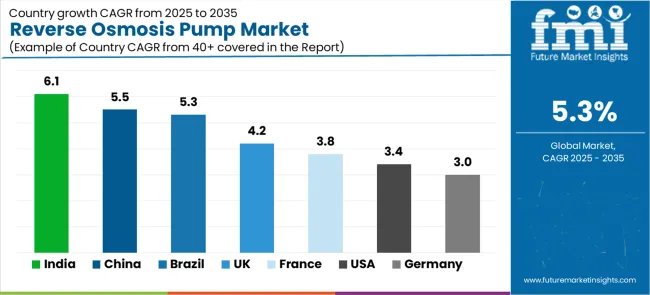
| Country | CAGR (2025 to 2035) |
|---|---|
| United States | 3.4% |
| China | 5.5% |
| Germany | 3.0% |
| United Kingdom | 4.2% |
| France | 3.8% |
| Brazil | 5.3% |
| India | 6.1% |
The reverse osmosis pump market is experiencing steady growth globally, with India leading at a 6.1% CAGR through 2035, driven by extensive water treatment infrastructure development, growing industrial water demand, and significant adoption of desalination technologies. China follows at 5.5%, supported by massive water treatment facility construction, rapid industrial expansion, and growing adoption of advanced pump technologies. Brazil shows growth at 5.3%, emphasizing infrastructure development and water treatment modernization. United Kingdom records 4.2%, focusing on water treatment optimization and operational efficiency improvement. France demonstrates 3.8% growth, supported by industrial water treatment upgrades and environmental compliance requirements. USA shows 3.4% growth, driven by infrastructure modernization but facing market maturity constraints. Germany demonstrates 3.0% growth, supported by advanced technology adoption but constrained by mature market conditions.
The report covers an in-depth analysis of 40+ countries;seven top-performing countries are highlighted below.
Revenue from reverse osmosis pumps in China is expanding at a CAGR of 5.5%, supported by the country's massive water treatment infrastructure development, extensive industrial expansion, and increasing adoption of advanced pump technologies. The country's comprehensive water management strategy and growing industrial water demand are driving sophisticated pump capabilities. State facilities and industrial companies are establishing extensive equipment operations to address the growing demand for efficient water treatment and operational reliability.
Revenue from reverse osmosis pumps in the USA is projected to exhibit growth with a CAGR of 3.4% through 2035, driven by water treatment infrastructure modernization programs and growing adoption of energy-efficient pump solutions supported by environmental regulations and operational efficiency initiatives. The country's established water treatment infrastructure and increasing investment in smart technologies are creating demand for advanced pump solutions. Major facilities and municipalities are establishing comprehensive equipment fleets to serve both domestic operations and industrial requirements.
Revenue from reverse osmosis pumps in Germany is expanding at a CAGR of 3.0%, supported by the country's strong engineering capabilities, advanced environmental regulations, and comprehensive water treatment modernization programs among industrial operators. The nation's mature water treatment sector and increasing emphasis on energy efficiency are driving sophisticated pump capabilities throughout the equipment market. Leading manufacturers and facilities are investing extensively in pump technology development and system integration to serve both domestic treatment needs and export markets.
Revenue from reverse osmosis pumps in the United Kingdom is growing at a CAGR of 4.2%, driven by expanding water treatment optimization programs, increasing operational efficiency requirements, and growing investment in infrastructure modernization. The country's established water management infrastructure and emphasis on environmental compliance are supporting demand for advanced pump technologies across major treatment markets. Water operators and industrial facilities are establishing comprehensive equipment programs to serve both domestic treatment needs and operational efficiency requirements.
Revenue from reverse osmosis pumps in France is expanding at a CAGR of 3.8%, supported by the country's focus on industrial water treatment infrastructure upgrades, comprehensive environmental compliance programs, and strategic investment in operational efficiency improvement. France's established manufacturing industry and emphasis on process optimization are driving demand for specialized pump technologies focusing on operational reliability and treatment quality. Industrial operators are investing in comprehensive equipment modernization to serve both domestic processing requirements and operational excellence initiatives.
Revenue from reverse osmosis pumps in Brazil is expanding at a CAGR of 5.3%, supported by the country's water treatment infrastructure development programs, growing industrial water demand, and increasing investment in operational modernization. Brazil's expanding industrial sector and emphasis on infrastructure improvement are driving demand for reliable pump technologies across major metropolitan treatment facilities. Industrial operators and municipalities are establishing service partnerships to serve both domestic infrastructure development and industrial processing markets.
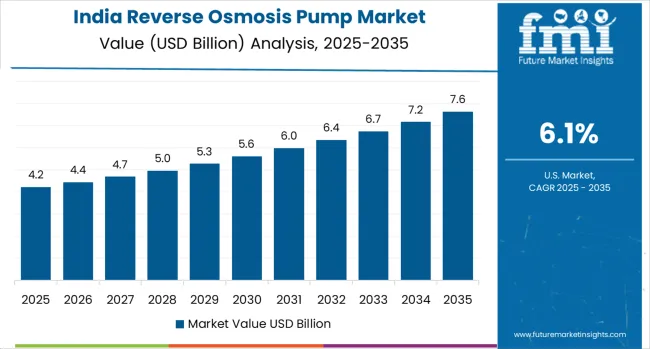
Revenue from reverse osmosis pumps in India is expanding at a CAGR of 6.1%, supported by the country's growing water treatment sector, increasing municipal infrastructure development, and strategic investment in industrial water processing capabilities. India's expanding industrial base and emphasis on operational efficiency are driving demand for cost-effective pump technologies across major treatment markets. Industrial facilities and municipal operators are establishing equipment partnerships to serve both domestic infrastructure expansion and operational efficiency requirements.
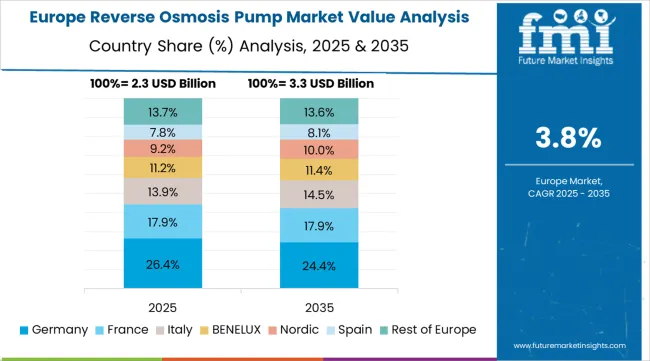
The reverse osmosis pump market in Europe is projected to grow from USD 2.8 billion in 2025 to USD 4.5 billion by 2035, registering a CAGR of 4.8% over the forecast period. Germany is expected to maintain its leadership position with a 34.8% market share in 2025, increasing to 35.2% by 2035, supported by its advanced engineering capabilities, comprehensive environmental regulations, and major water treatment facilities serving European and international markets.
France follows with an 18.2% share in 2025, projected to ease to 17.8% by 2035, driven by industrial water treatment modernization programs, environmental compliance initiatives, and established manufacturing capabilities, but facing challenges from competitive pressures and infrastructure investment constraints. United Kingdom holds a 16.4% share in 2025, expected to reach 16.6% by 2035, supported by water treatment optimization requirements and operational efficiency initiatives. Italy commands a 12.1% share in 2025, projected to reach 12.3% by 2035, while Spain accounts for 10.8% in 2025, expected to reach 11.0% by 2035. The Rest of Europe region, including Nordic countries, Eastern European markets, Belgium, Netherlands, and other European countries, is anticipated to gain momentum, expanding its collective share from 7.7% to 8.1% by 2035, attributed to increasing water treatment development across Nordic countries and growing infrastructure modernization across various European markets implementing treatment upgrade programs.
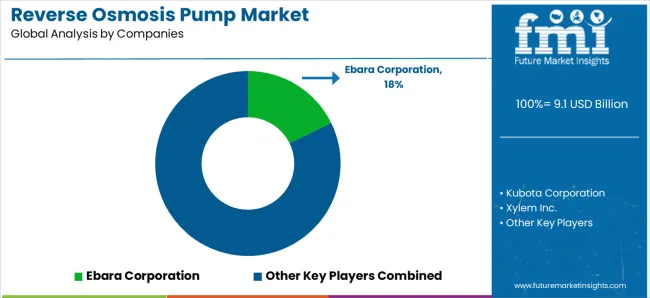
The reverse osmosis pump market is highly competitive, driven by key players from the industrial pump and water treatment sectors. Ebara Corporation and Kubota Corporation lead the market, holding shares of approximately 18% and 15%, respectively. Ebara’s strong position is attributed to its advanced pump solutions, which cater to water treatment and desalination plants, while Kubota is renowned for its robust and efficient pumps used in large-scale water filtration systems. Xylem Inc. follows closely with a market share of around 12%, offering a wide range of water treatment solutions with advanced energy-efficient pump designs. Sulzer AG and Flowserve Corporation account for approximately 10% and 9% of the market, respectively, providing high-performance pumps for reverse osmosis applications across various industries, from municipal water treatment to industrial desalination. Grundfos, with a market share of 8%, and Danfoss with 7%, are recognized for their energy-efficient solutions and advanced pump technologies in reverse osmosis systems. Wier Group and KSB Group each contribute about 6%, providing specialized pump systems and solutions for water treatment and filtration. Wilo SE holds a market share of approximately 5%, offering reliable pumps for commercial and residential applications. These companies compete based on pump efficiency, reliability, energy consumption, and the ability to meet the growing demand for clean water solutions in both industrial and municipal applications.
| Items | Values |
|---|---|
| Quantitative Units (2025) | USD 9.1 billion |
| Technology Type | Centrifugal Pumps (Single Stage, Multi Stage), Diaphragm Pumps |
| Application | Domestic &Commercial, Industrial RO Filtration, Seawater Desalination |
| Pump Type | Booster Pumps, Delivery/Demand Pumps |
| Flow Rate | 0.1 to 0.5 GPM, 0.5 to 1 GPM, 1.1 to 5 GPM, 5 to 20 GPM, 20 to 100 GPM, 100 to 500 GPM, 500 to 1000 GPM |
| Regions Covered | North America, Latin America, Western Europe, Eastern Europe, East Asia, South Asia Pacific, Middle East &Africa |
| Countries Covered | United States, Canada, Germany, United Kingdom, France, China, Japan, Brazil, India and 40+ countries |
| Key Companies Profiled | Ebara Corporation, Kubota Corporation, Xylem Inc., Sulzer AG, Flowserve Corporation, and Grundfos |
| Additional Attributes | Pump sales by technology type and application, regional demand trends, competitive landscape, technological advancements in energy efficiency, smart monitoring development, performance optimization, and operational reliability enhancement |
The global reverse osmosis pump market is estimated to be valued at USD 9.1 billion in 2025.
The market size for the reverse osmosis pump market is projected to reach USD 15.3 billion by 2035.
The reverse osmosis pump market is expected to grow at a 5.3% CAGR between 2025 and 2035.
The key product types in reverse osmosis pump market are centrifugal pumps and diaphragm pumps.
In terms of application, industrial ro filtration segment to command 52.1% share in the reverse osmosis pump market in 2025.






Full Research Suite comprises of:
Market outlook & trends analysis
Interviews & case studies
Strategic recommendations
Vendor profiles & capabilities analysis
5-year forecasts
8 regions and 60+ country-level data splits
Market segment data splits
12 months of continuous data updates
DELIVERED AS:
PDF EXCEL ONLINE
Market Share Insights for Reverse Osmosis (RO) Pump Providers
Reverse Tuck Box Market Size and Share Forecast Outlook 2025 to 2035
Reverse Cap Bottles Market Size and Share Forecast Outlook 2025 to 2035
Reverse Logistics Market Size and Share Forecast Outlook 2025 to 2035
Reverse Transcriptase Enzymes Market Size and Share Forecast Outlook 2025 to 2035
Reverse Tuck Cartons Market
3D Reverse Engineering Software Market Forecast and Outlook 2025 to 2035
Q-Commerce Last-Mile Thermal Packs & Reverse Logistics Market Analysis - Size, Share, and Forecast Outlook 2025 to 2035
Pump Jack Market Forecast Outlook 2025 to 2035
Pump and Dispenser Market Size and Share Forecast Outlook 2025 to 2035
Pump Testers Market Size and Share Forecast Outlook 2025 to 2035
Pumpjacks Market Size and Share Forecast Outlook 2025 to 2035
Pumps Market Size and Share Forecast Outlook 2025 to 2035
Pumpkin Seed Protein Market Size and Share Forecast Outlook 2025 to 2035
Pumped Hydro Storage Market Size and Share Forecast Outlook 2025 to 2035
Pump Tubes Market Size and Share Forecast Outlook 2025 to 2035
Pumpkin Pie Spices Market Analysis - Size, Share, and Forecast 2025 to 2035
Pumps and Trigger Spray Market Trends - Growth & Forecast 2025 to 2035
Pump Condiment Dispensers Market - Effortless Portion Control 2025 to 2035
Pumpkin Spice Products Market Trends - Seasonal Demand & Growth 2025 to 2035

Thank you!
You will receive an email from our Business Development Manager. Please be sure to check your SPAM/JUNK folder too.
Chat With
MaRIA